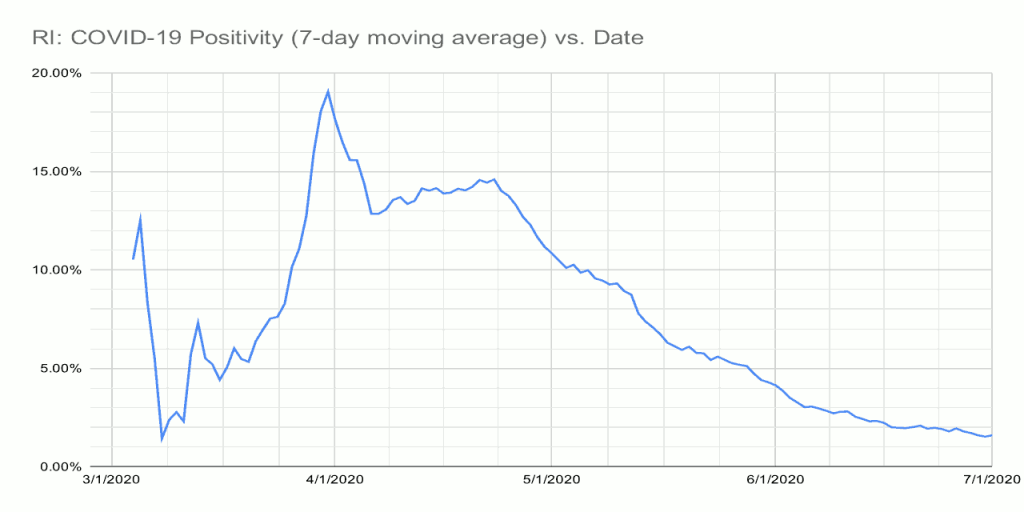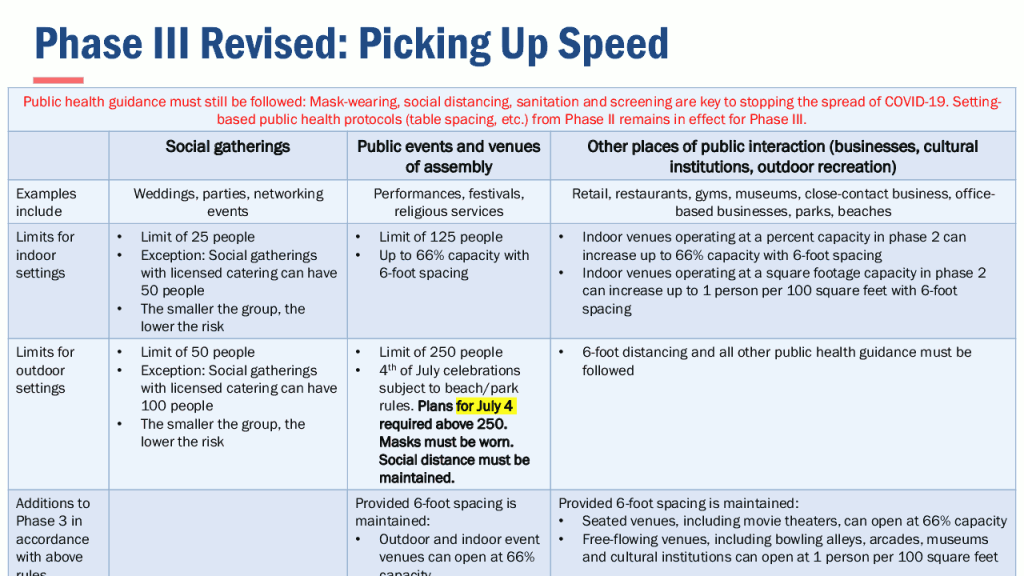As Rhode Island literally leads the nation in rate of decline for cases of COVID-19, Gov. Gina Raimondo moved forward with plans to enter Phase 3 of reopening the state economy on Tuesday, June 30. Depending upon criteria, Connecticut and New Jersey are in contention for second place, but everyone agrees RI is first.
The official terms and conditions for Phase 3 are specified in the 10-page Executive Order 20-50 signed by the governor on June 29, incorporating additional rules subsequently issued by executive agencies such as the Department of Health (DoH) and the Department of Business Regulation (DBR). In most cases, the rules have the force of law and in extreme cases violations could entail fine or imprisonment, but enforcement efforts have been directed entirely at businesses and no individual has so far been cited.
Information about COVID-19 is centralized by the state on the DoH website at health.ri.gov/covid and about phased reopening on a dedicated website reopeningri.com, both widely advertised everywhere from the governor’s press conferences to highway signs.
On April 27 before Phase 1, Raimondo outlined the consistent criteria to be used in deciding whether it was safe to move into each next phase of reopening. As these criteria evolved, they reduced to four key quantitative metrics:
- Hospital beds occupied below 70% capacity; currently below 20%
- Hospital admissions below 30 daily; currently below 15
- Hospitalizations doubling no faster than 30 days; currently declining
- Rate of spread (“R0” or “R-naught”) below 1.1; currently estimated 0.6
All four metrics are independent of testing volume or accuracy, and are tied to directly measured or deduced data such as hospital patient counts. An R0 of 1.0 would result in a steady number of cases as each infected person transmitted the virus to one other person before themselves either recovering or dying, while R0 less than 1.0 would result in an overall decrease of total current cases and R0 greater than 1.0 would result in an overall increase of total current cases.
Travel restrictions
Recent spikes elsewhere in the country caused Connecticut, New Jersey and New York to impose a 14-day quarantine requirement, effective June 25, on travelers coming from the eight states (Alabama, Arkansas, Arizona, Florida, North Carolina, South Carolina, Utah and Texas) with 7-day moving averages either (a) more than 10% of tests for the virus producing positive results (“positivity”) or (b) more active cases than 10 per 100,000 population. Effective June 30, the list was expanded to add eight more states (California, Georgia, Iowa, Idaho, Louisiana, Mississippi, Nevada, Tennessee).
Rather than follow neighboring states, RI opted for a rule both simpler and more strict: travelers coming into RI from states with positivity greater than 5% are subject to 14-day self-quarantine, but can can exempt themselves either by (a) testing negative within 72 hours before arriving or (b) testing negative after arriving. RI uses public data from Johns Hopkins University to determine the 24 states and territories affected as of June 29 (Alabama, Arizona, Arkansas, California, Florida, Georgia, Idaho, Iowa, Kansas, Louisiana, Mississippi, Missouri, Nebraska, Nevada, North Carolina, Oklahoma, Oregon, Puerto Rico, South Carolina, South Dakota, Tennessee, Texas, Utah, Washington). International travelers remain subject to a 14-day self-quarantine requirement, with no testing exemption.
COVID-19 testing

(Source: data by RI DoH; chart by Michael Bilow)
RI currently leads the nation in COVID-19 testing, completing 248,268 tests as of July 1, slightly more than 23% of the total population, actually testing about 4,000 daily with capacity for 5,000. Positivity (calculated as a 7-day moving average to remove day-of-week bias) for July 1 was 1.9%, after a fairly steady decline from a peak on March 31 of 19.0%.
Testing is critical to avoiding economic shutdown, as it allows identifying those infected and isolating them in quarantine so they cannot infect others, while tracing their contacts to in turn test them for infection. Without adequate testing, the only option is to assume everyone is potentially infected, necessitating economic shutdown.
All testing is by appointment only. RI offers free testing to residents (portal.ri.gov). Anyone with symptoms should be tested immediately and quarantine. People without symptoms are encouraged to be tested to contribute data to help the public health effort if their work brings them into “close contact” with a significant number of customers (waiters, barbers, hairdressers, nail technicians, cosmeticians, estheticians, tattoo artists, body piercers, personal trainers, massage therapists, bus drivers) or they have attended large gatherings such as protests.
Non-residents without symptoms can be tested in RI, either by paying out-of-pocket or covered by their health insurance, at participating urgent care facilities (listed at health.ri.gov/covid/travel), about two-thirds of which also offer services in Spanish. Non-residents coming into RI are encouraged to be tested before departing. Anyone with symptoms should not be traveling at all.
Gatherings and events

(Source: ReOpeningRI.com)
By far the most significant change in Phase 3 affecting daily life in RI is the substantial increase in maximums for allowed gatherings, generally limited to 15 people in Phase 2, just in time for the July 4 holiday weekend. General classifications, such as whether a particular type of business or venue is limited by percent capacity or square footage, are carried over from Phase 2.
In all cases, it is expected that minimum physical spacing of six feet be maintained and that face coverings be worn whenever possible.
The new regulations include a lot of complexity as they try to distinguish indoor versus outdoor, social gatherings versus public events, seated versus free-flowing venues, and so on, but these distinctions do make sense once explained.
For events, the rules distinguish between “social gatherings” where most of the attendees will know each other and mingle, such as parties or wedding receptions, as opposed to “public events” where most of the attendees will keep to their own tiny group and not mingle with other attendees, such as concerts, festivals, and ordinary religious services (not weddings and funerals).
- Mingle events without a licensed caterer are limited to 25 attendees indoors and 50 outdoors
- Mingle events with a licensed caterer are limited to 50 attendees indoors and 100 outdoors
- Non-mingle events are limited to 125 attendees indoors and 250 outdoors, but not more than 66% capacity
For ordinary operations (that is, not events):
- Indoor venues with seats, such as places of worship, theaters, restaurants, cultural institutions, factories, and office-based businesses, are limited to 66% capacity
- Indoor venues without seats, such as retail stores, museums, bowling alleys, arcades, gyms, and recreational facilities, are limited to to 1 person per 100 sq ft
- Outdoor venues, such as parks and beaches, are unlimited as long as six-feet distancing is maintained
Particular venues will have to consider how these general limits apply to them, and many types of venues will be much more tightly constrained. Movie theaters, for example, could never come close to 66% of capacity while maintaining six-feet separation, and likely would be unable to exceed 25%. Live theaters with fixed seats, such as PPAC or Trinity Rep, would similarly be severely limited, but large spaces using folding chairs, such as the WaterFire Arts Center, might be able to reach 66%.
Certain businesses, notably bars, are considered dangerous and highly conducive to transmission of the virus, and RI is only allowing bars to open if they can operate as sit-down restaurants with table service instead of a bartender because congregating at the bar is untenably risky. Over 100 cases in Louisiana and over 300 cases in Minnesota were traced to recent reopening of bars where physical distancing and wearing face coverings were largely ignored, and Dr. Anthony S. Fauci, the top infectious disease expert in the US government, said in testimony to Congress on June 30, “Outdoor better than indoor. Bars really not good. Really not good. Congregation in a bar inside is bad news. We’ve really got to stop that right now when you have areas that are surging like we see right now.”
Compliance
Inspections of businesses have found nearly 99% compliance with physical distancing and face covering requirements by workers and approximately 95% compliance by customers, Raimondo said. The most serious deficiency was that, when inspectors asked for it, only 80% of businesses had filled out and signed the compliance plan required to be placed on file. Many customers at drive-through windows simply fail to realize that they should wear their face covering because the server will be within six feet.
State officials have repeatedly emphasized that the outstanding track record in RI of suppressing spread of the virus, compared with other states, has been the extremely good rate of compliance with physical distancing, face cover wearing, hand washing, and – most importantly – staying home and isolating if sick with symptoms.
If compliance drops and people get complacent, the governor warned, RI may go the route of other states and have to close down again as cases begin materializing in the next few weeks.
More Posts by The Author:
Heavy Rain, High Winds, Flooding Wed–Thu: Advisory for wind, watches for inland and coastal flooding posted
River Flood Warnings in RI, MA, CT: Wed through Fri, streets may be impassable at times
Snow possible but unlikely Sat mid-day: Little accumulation likely
Snow Thu Night: One inch expected
Significant Snow Storm Tue 5am – 3pm: Likely 6in but remote possibility up to 18in


